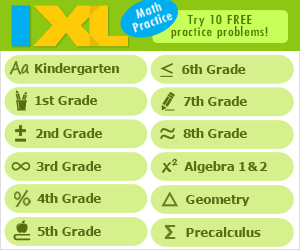6th Grade Geometry and Measurement
To work on sixth grade geometry and measurement standards, click on the numbers below to visit pages with resources for each of the learning standards.
Checks for Understanding are at the top of this page. Scroll down to find internet resources related to the State Performance Indicators (SPIs).
Checks for Understanding (Formative/Summative Assessment)
Angle Sum - Investigate the sum of the angles in a triangle and a quadrilateral using various methods. 0606.4.2 Triangle/Polygon - Relate the sum of the angles in a triangle to the sum of the angles in polygons. 0606.4.3 Protractor/Ruler - Verify the basic properties of triangles and quadrilaterals using a protractor and ruler. 0606.4.4 Classify Triangles - Classify triangles by side lengths (scalene, isosceles, and equilateral) and angle measure (acute, right, obtuse, isosceles and equiangular). 0606.4.5 Inequality Theorem - Model and use the Triangle Inequality Theorem. 0606.4.6 Interior/Exterior - Use the properties of interior and exterior angles of polygons to solve problems. 0606.4.7 Transformations - Work with transformations in a plane and explore their meanings through drawings and manipulatives. 0606.4.8 Scaling/Dilation - Understand scaling, dilation and their relation to similarity. 0606.4.9 Congruence - Analyze the differences between congruence and similarity. 0606.4.10 Transformation - Describe the effect of a transformation on a 2-dimensional figure and the resulting symmetry. 0606.4.11 Circumference - Relate the circumference of a circle with the perimeter of a polygonal figure. 0606.4.12 Pi - Derive the meaning of Pi using concrete models and/or appropriate technology. 0606.4.13 Understanding Pi - Understand the relationships among the radius, diameter, circumference and area of a circle, and that the ratio of the circumference to the diameter is the same as the ratio of the area to the square of the radius, and that this ratio is called Pi. 0606.4.14 Area - Relate the area of a trapezoid to the area of a parallelogram. 0606.4.15 Length - Find lengths given areas or volumes, and vice versa. 0606.4.16 Contextual - Solve contextual problems involving area and circumference of circles, surface areas and volumes of prisms, pyramids, cones, and cylinders. 0606.4.17 Manipulative - Use manipulatives to discover the volume of a pyramid is one-third the volume of the related prism (the heights and base areas are equal). 0606.4.18 Cone Volume - Use manipulatives to discover the volume of a cone is one-third the volume of the related cylinder (the heights and base areas are equal).
State Performance Indicators
SPI 0606.4.1 Geometric Shapes - Identify, define or describe geometric shapes given a visual representation or a written description of its properties. SPI 0606.4.2 Missing Angle - Find a missing angle measure in problems involving interior/exterior angles and/or their sums. SPI 0606.4.3 Triangle Inequality - Solve problems using the Triangle Inequality Theorem. SPI 0606.4.4 Circumference - Calculate with circumferences and areas of circles. SPI 0606.4.5 Surface Area - Determine the surface area and volume of prisms, pyramids and cylinders. SPI 0606.4.6 Volume - Given the volume of a cone/pyramid, find the volume of the related cylinder/prism or vice versa. Geometry [Grades 6-8]

Measurement [Grades 6-8]
Search Internet4Classrooms

Custom Search






